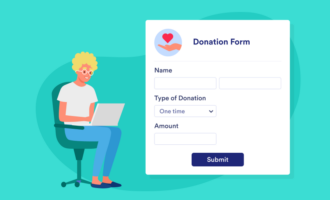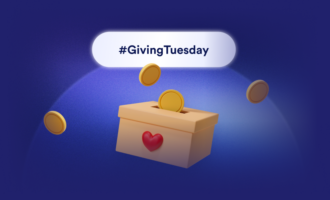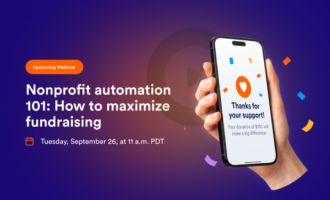Nearly one-third of annual giving occurs in December, and almost 12 percent of all giving happens in the last three days of the year.
Year-end giving is one of the most exciting but also overwhelming times for fundraising professionals. It includes all fundraising efforts and donations from Giving Tuesday until the new year. This is when donors usually have a better sense of their financial standing, and the holiday spirit inspires charitable feelings.
You may still be in the aftermath of last year’s year-end fundraising efforts, but this doesn’t mean you can rest on your laurels. Thinking about your year-end fundraising strategy now can help you develop other fundraising efforts throughout the year and set you up for growth in the new year.
In this guide, you’ll learn the essential tips to follow if you want to maximize your year-end fundraising for the new year:
Essential tips on maximizing your year-end fundraising for the new year
- Review metrics from past year-end fundraising efforts.
- Consider the organization’s current standing, and set goals.
- Create a campaign time line.
- Use prospect research to supplement your year-end strategy.
- Segment your audience.
- Perfect your fundraising appeals.
Review metrics from past year-end fundraising efforts
- How much did you raise during the last months of the year? This gives you a good sense of whether your overall strategy was a success or if there are some key pieces you need to work on.
- How did you thank your year-end donors? In order to develop positive donor relationships and set the stage for future engagement, you have to show donors appreciation. Make sure to send your appreciation letter very soon after the gift is made and explain the impact it’s going to have.
- How many major gifts were made? Studies have shown that, on average, over 88 percent of all funds raised came from just 12 percent of donors. Major donors have an incredible impact, so determining who they are, especially for your year-end fundraising campaign, is important. It’s a good idea to foster relationships with these donors, especially for your next year-end campaign.
- What materials, channels, and strategies did you use? Take a look at the strategies and outlets for your last year-end fundraising campaign. This is a good way to weed out your strategies for this year.
Consider the organization’s current standing, and set goals
- Has your nonprofit’s fiscal situation changed? If your nonprofit has more money than last year, consider putting more into your fundraising efforts.
- How will the funds you raised last year affect your overall mission and nonprofit operations? Make sure you understand how much of the funds you raised is going directly to your mission and how much is going to an annual fund. This gives you a better sense of how to set your goals for the year.
- What strategies were most successful throughout the entire year? Determine which strategies you should implement this year and which ones aren’t worth investing time and money into.
- Set a budget for the campaign.
- Set goals about the impact you want your nonprofit to have.
- Set a yearly fundraising goal (not just year-end).
Create a campaign time line
- Summer: Start finalizing your campaign strategy and set concrete, actionable goals for the end of the year.
- September: Begin segmenting your donor list to get a sense of who to focus your year-end fundraising efforts on.
- October: Draft your year-end giving appeals and prepare your online giving channels. These are your first efforts for Giving Tuesday.
- November: Giving Tuesday, the Tuesday after Thanksgiving, kick-starts the giving season. This is when you send your first round of giving appeals and fundraising letters.
- December: Send follow-up asks, update donors on the current progress of the campaign, and send your initial thank-yous.
- January: Now that your year-end giving campaign is coming to an end, make sure to let your donors know how their gifts have impacted your cause.
Use prospect research to supplement your year-end strategy
- Philanthropic indicators like past giving, other charitable affiliations, and political giving. This represents a donor’s affinity to give and how likely they are to make a charitable gift.
- Wealth markers like real estate ownership, stock ownership, and business affiliation. This represents a donor’s capacity to give and how much they could donate.
Segment your audience
- Matching gift eligible donors. Possibly double (or triple!) your donations by sending out corporate philanthropy marketing materials to eligible donors. You can find eligible donors through prospect research or an advanced matching gift tool.
- Donors with donor-advised funds (DAFs). According to this article, DAFs are a growing form of philanthropy and can make a huge impact on your year-end giving funds. Use your prospect research tool to determine which of your donors might have a DAF, and prioritize those relationships.
- Current donors, lapsed donors, and prospective donors. Your communications with different donors are going to differ depending on their current relationship with you. For example, current donors might receive a more casual email while lapsed donors might receive a handwritten letter with more compelling details.
- Donors based on gift sizes. Your communications with recurring major donors should be different than your communications with someone who donated a small amount once.
Perfect your year-end fundraising appeals
- Remind donors of the success of your last year-end campaign. Start your fundraising appeal by talking about how much money was raised last year and the impact you were able to make together. This shows donors that your organization is actually doing something meaningful and motivates them to be a part of it this year.
- Keep your letters donor-centric. As mentioned before, personalize your donor engagements to better connect with your donors.
- Find the best communication channel. Ask your donors what their preferences are, especially in terms of how they want to be reached. Whether they prefer email or direct mail, try to adhere to their preferences.
- Suggest a giving level and specify the associated impact. A great way to incentivize donors is to suggest a donation amount and then explain what that gift would do for your cause. For example, “with a donation of X, we can provide drinking water to Y amount of kids.” This way, donors know that their gift is going to a genuine cause.
To summarize your year-end giving efforts from last year and kick-start your next campaign, take the time to review the metrics and data. Start by determining how your year-end giving campaign did, both financially and strategically. Take a comprehensive look at your fundraising tools, donor database, and the total yearly fundraising revenue.
Ask yourself these questions:
Taking the time to review your past efforts and campaigns gives you a better sense of how to improve your next campaign.
Once you’ve successfully evaluated your previous fundraising efforts, start thinking about this new year. To effectively plan your year-end strategy and campaign, you have to know what’s feasible, what you’d like to accomplish, and what your donors respond to.
Ask these questions to get the process started:
After you get a sense of what your nonprofit is capable of or where you want to go in the upcoming year, set up some year-end goals and guidelines to frame your fundraising efforts:
You can’t create the right fundraising strategy without any context. You’ll risk setting unrealistic expectations and end up not accomplishing much.
To ensure that you and the rest of your fundraising team are on the same page, it’s a good, strategic idea to write down and document a time line for your year-end efforts.
Your campaign time line depends on the size of your organization, the breadth of your donor base, and your goals. According to Nonprofit Hub, most organizations (around 54 percent) start planning their year-end asks in October. However, if you’re trying to make this year-end fundraising campaign the best one yet, one month of preparation might not be enough.
While you should review your past year-end efforts as soon as they’re over, the summer months are a good time to really finalize your year-end campaign. Here’s an example of what a good time line looks like; you can easily tweak it to fit your goals and needs:
Creating a campaign time line will help you visualize the rest of the year and keep your team on the right track. This way, you have actionable goals and steps to take along the way.
A great way to supplement and support a year-end fundraising strategy is to leverage your donor data. It’s common knowledge in the fundraising world that the more you get to know your donors, the better you’ll be able to engage with them and the stronger your relationship will be.
Many nonprofits will turn to prospect research in order to learn more about their donors and identify those who have the potential to make a big impact.
How does prospect research work? Start by screening your donor base for specific traits and using that data to make informed assumptions. Prospect research professionals will look for these two types of metrics:
Donors with both a high affinity to give and a high capacity to give are likely to become major donors.
It’s a good idea to invest in a prospect research tool that automates this process. The tool will screen your donors against vast philanthropic databases and help you narrow down who might be potential major donors.
It’s probably best to do this step early on in your year-end planning so you can start developing relationships with those donors. Just because a donor has a lot of money and is feeling philanthropic doesn’t mean they’ll be giving to you. Putting effort into the relationship can help increase the chance for a major gift.
As you’re beginning your year-end fundraising campaign, consider the best ways to reach your donors. A great email marketing tactic that many nonprofits depend on and have seen success with is audience segmentation.
Segmenting your donors helps you not only organize your various fundraising initiatives but also personalize your donor communications. Donors don’t want to feel like one of many, and the more effort you put into individualizing your engagements, the closer they’ll feel to your cause.
Don’t bog down your donors by sending them content that doesn’t apply to them. Consider segmenting your audience by these traits:
You’ll be better able to reach your donors by narrowing down your marketing efforts and segmenting your audience.
When November and Giving Tuesday come around, you should be sending out your year-end fundraising appeals. However, don’t just ask your donors for money. Hopefully, you’ve been able to foster these relationships throughout the year so you have a stable foundation for your fundraising letter.
To perfect your year-ending fundraising appeal, consider the following best practices to get the best results and maximize success:
Fundraising appeals and other donor engagements depend on the context of the situation and the type of organization you work for. If you’ve hit writer’s block and need guidance, check out these fundraising letters for more than 70 templates to get you started.
As you begin the new year, it’s a great time to reflect on your nonprofit processes, fundraising strategies, and the impact your organization has made on your mission. It’s always a good idea to think about your year-end fundraising efforts and how you can improve for next year.

























Send Comment: